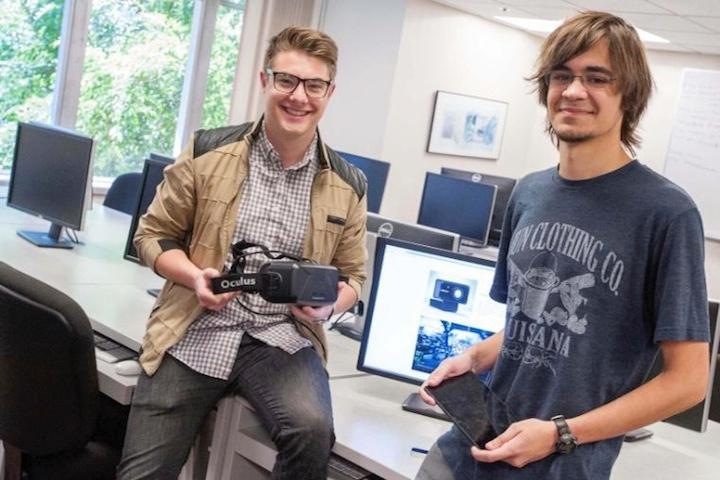
Facing Fears through Virtual Reality
While some might fear public speaking to the point of calling it a phobia, two students bravely face that anxiety by talking about their work to alleviate the fears of others. For their Senior Design project, Bryce Mariano (web design and engineering major, studio art minor) and Paul Thurston (computer science and engineering major) have developed a simulation tool for therapists to use in guiding patients through a controlled virtual world of exposure to potentially terrifying things.
With a post-university goal of starting careers in the video game industry—more precisely, within the category of serious or interactive games—the pair were looking for a project that could afford the experience they'd need to follow their dreams while also providing a social benefit, preferably in the area of psychological treatment.
Fortunately, academic advisor and computer engineering Adjunct Lecturer Maria Pantoja was there to help. "At a conference last year," she said, "I saw a presentation about therapeutic video games by Adam Gazzaley M.D, Ph.D.—his team is seeking the first FDA approval for these games' use—and I thought this was fantastic. My students know I like to design video games, so every year I have groups that want to do capstone projects related to gaming. Developing therapeutic video games beautifully pairs a desire for a career in video game design with the SCU mission of giving back to society."
With the seed for their project planted, Thurston reports, "Our biggest challenge at the beginning was that because we're engineering students, we didn't understand the psychology side. We reached out to Dr. Kieran Sullivan [professor and chair of SCU's psychology department] and through our own research and her feedback, we decided to create a tool to treat phobias such as fear of heights or flying."
Their technique uses the Oculus Rift hardware (picture a cross between goggles and a welder's mask), a head-mounted 3D display device that tracks head orientation, allowing users to experience the virtual world from their own vantage point. Mariano, who interned as a graphic designer, worked on the simulation design, while Thurston, who helped program the control system for SCU's 2013 Solar Decathlon house, programmed the controls communication between a computer tablet and the Oculus. He also created a mobile app the therapist uses to control the session.
They started with a fear of heights simulation. As the patient takes in a 360-degree view from atop a building, the therapist can alter the virtual height and the resultant view—backing off or increasing exposure as needed according to the patient's emotional response. While the team stresses that their tool is for use by trained therapists, not for sufferers to use on their own, Thurston notes that just knowing you can take the goggles off while immersed in the experience may make this form of treatment more approachable for some.
"Another aspect of our project that has been very important to us is to keep it affordable as well as accessible for future development," said Mariano. "By using economical hardware and developing the simulation using the Unity Game Engine, which is 100 percent free and readily available, we hoped to create a platform that would allow others to easily pick up the project where we left off and continue expanding on the library of simulations to treat the widest possible range of phobia patients."
Pantoja appreciates the interdisciplinary experience the project affords the students. "We are really lucky that we can count on the support of the College of Arts and Sciences. The help we are getting from Dr. Sullivan is invaluable. Also, for this project, and for all the video game projects I advise, I call on the expertise of computer engineering alumnus Chris Menezes '10. Chris works at Disney/Pixar and is providing us with advice on how the video game development process works in the 'real world' and how to make games more appealing to customers," she said.
Sullivan adds: "Using cutting-edge technology to create a therapeutic and safe environment for folks struggling with anxiety disorders holds incredible promise. I'm so excited that Bryce and Paul have chosen this for their project." Pantoja sees such projects as just the beginning. "There are tremendous opportunities out there that are limited only by our imagination."